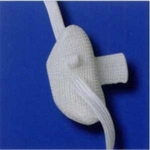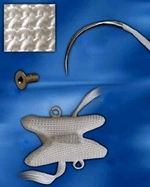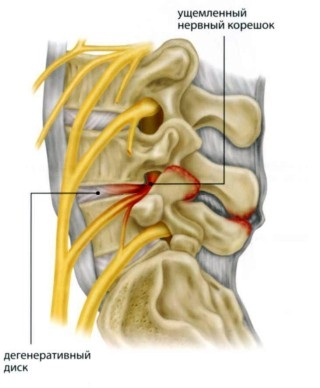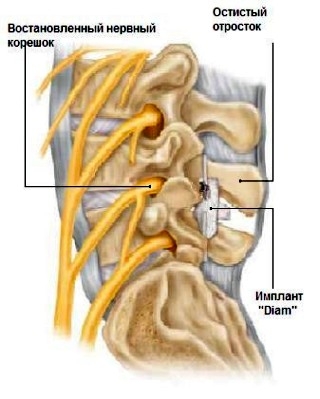Spine dynamic fixation with DIAM system
 The dynamic fixation of the spine from the moment of its invention was always attractive for surgeons and patients since it provides elastic stabilization of the treated segment and removes the hard constraints, inherent in rigid fixation. There are several generations of devices for the dynamic fixation.
The dynamic fixation of the spine from the moment of its invention was always attractive for surgeons and patients since it provides elastic stabilization of the treated segment and removes the hard constraints, inherent in rigid fixation. There are several generations of devices for the dynamic fixation.
DIAM is the new concept in the treatment of back and lower limb pain. DIAM implant is the construction for the dynamic stabilization of the spine in treating the lower back pain and pain irradiating into lower limbs. The core of the implant is made from silicone, its outer shell - from the polyethylenterephthalat (polyester), and the locking device is made from titanium. The first DIAM implantation for dynamic spine fixation happened in 1996, at present already thousands of such operations have been done.
DIAM implantation is minimally invasive procedure. It can be done at early stages and provides dynamic stabilization, restoring the correct balance of the rear spinal column, ensuring stability and absorbing loads on the intervertebral disc.
 DIAM is the interspinal shock absorber. Its unique configuration provides stability thanks to elongated wings, which cover spinous processes.
DIAM is the interspinal shock absorber. Its unique configuration provides stability thanks to elongated wings, which cover spinous processes.
The unique feature of the systems for interspinal dynamic fixation is the possibility for simultaneous flexure and extension in the spinal segment, which prevents injury to the adjacent levels.
By two independent bands, DIAM implant attaches to the adjacent vertebrae, which ensures its correct position, stable fixation, especially during the flexure.
Flexure starts with the decrease of compression to DIAM and continues with the stretching of other passive structures: muscles, fascias, and ligaments. During the extension DIAM is compressed to the point, limited by the property of material. DIAM takes the role of the equilibrium center, preventing load on the facet joints. Thus, the motion of spinal segment is controlled both during flexure and extension. Due to the stretching with DIAM, the height of intervertebral foramen increases, which decreases the compression of the nervous root.


Principles and the unique features of DIAM dynamic spine fixation
- Stabilization, which preserves the physiological spine functioning;
- Restoring normal anatomy;
- Decrease in pain;
- Simple and familiar surgical access;
Indications for use
- foraminal stenosis;
- disc herniation and signs of segmental instability;
- transient pain in the segments, adjacent to spinal fusion;
- arthrosis of facet joints.
What happens after DIAM implantation?
Results of operation are evident. After the correctly executed procedure pain decreases, and the patient can return to normal activities. Potential benefits of DIAM fixation are following:
- elimination of pain;
- restoration of disc height and spinal balance;
- the increase in the spine stability;
- preservation of spine mobility.
Contraindication
DIAM cannot be implanted in patients with acute infections, the allergy to silicone, polyethylenterephthalat or titanium, and to the pregnant women.


